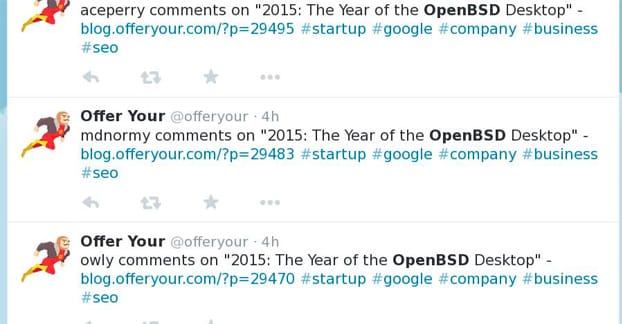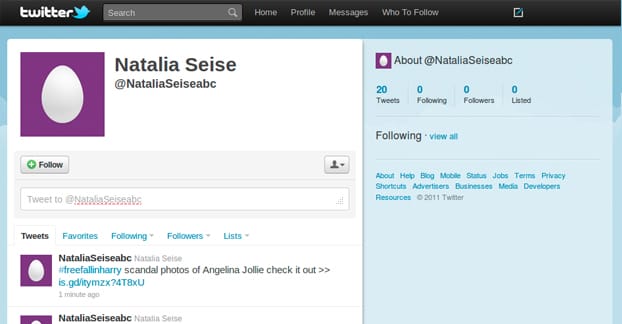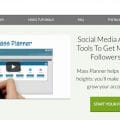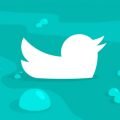There is a bit of an interesting phenomenon on Twitter that relates to follows and the behavior people exhibit with them. See, on a site like Facebook, you have a few different types of relationships. A profile can send a friend request to another profile, and that other profile has to approve it. When they do, there’s a reciprocal relationship; both profiles are friends with each other. A profile can also follow another profile, or a page, for a one-sided relationship. Reciprocal follows are possible, but at that point the two users may as well forge a friendship instead. Pages cannot follow or friend profiles, but can follow other pages. It’s all an odd mixture.
On Twitter, there are no pages versus profiles. There are no mutual relationships enforced by mandatory platform rules. There’s no distinction between one account and another, other than verification or various social metrics. Mechanically, they are all the same.
The one relationship you can have with another person on Twitter is to follow their account. Because there’s no reciprocal relationship by default, however, people have invented it. Among some circles, there’s the prevalent idea that when someone follows you, you should follow them back.
This has even been extended into events and hashtags. You see #FollowFriday, or Follow Back Friday, as events where anyone using the hashtag can discover and follow anyone else using it, and everyone follows each other. The idea originated in a more limited form, created by Micah Baldwin. His idea was that each week he – or someone in a prominent position on Twitter – would suggest someone to follow, rather than everyone reciprocating following each other.
There are even Twitter bots – and functions built into Twitter managers – to automatically follow back anyone who follows you.
The Exploitation of Reciprocation
This, of course, led black hat marketers to immediately discover a way to exploit this. They would insert themselves into the hashtag discussion to earn a bunch of reciprocal follows. Often, they would only save those follows for a few days or weeks. After that time, they would simply unfollow the majority of the people they followed. It made it look like their accounts had accumulated a lot of followers organically, when it was really an exploit.
These same black hat marketers would exploit bots as well. They would mass follow anyone they could find, and wait for reciprocal follows. If no reciprocation happened, they would unfollow the account immediately. If reciprocation did happen, they would wait for the unfollow for a while, to make it seem more legitimate and to save more of the follows.
This, of course, let to even more exploitation. Why do any of that manually when you can program a bot to do it for you? Black hat marketers would unleash a bot on large, popular hashtags and rake in the reciprocal follows. Over time, they would end up with audiences in the thousands or tens of thousands, none of whom really followed them.
They often combined this with one other exploit; changing the branding of an account. Often these black hat marketers were just creating accounts for attractive women, populating them with a few pictures and some basic tweets, and then hoarding follows as much as possible. Then, when their account had enough follows, they would sell it to the highest bidder. When the account was sold, the pictures and tweets would be removed, branding would be added, and the new owner would be presented with a ready audience. Not an interested audience, of course, but a present audience.
You can imagine how much worse this could get when you add on the idea that many of the accounts that did reciprocal follows would also be bots.
Why it Doesn’t Work
There are an absolute ton of reasons why this technique was only barely successful five years ago when it came out, and pretty much doesn’t do a thing for you these days. Want a list? Good, because I’m going to give you a list.
1: People don’t reciprocate that often any more. This is, perhaps, the number one reason why mass follows just don’t work. There used to be etiquette that encouraged reciprocation, but it very quickly became obvious to most people that following too many accounts made it impossible to use the site.
See, unlike Facebook, Twitter does not have a filter on the feed. It’s strictly chronological, with new tweets appearing first, at the top of the list. I have an account that only follows 65 people, and it gets 150+ new tweets per hour, with even more during peak hours. It’s hard enough trying to keep up with that without having it ping me every minute. Can you imagine how hard it would be to keep up with an account following thousands of people?
Sure, Twitter provides lists for this sort of functionality. You can follow 10,000 people but spend most of your time in a list of only 20, and the feed from 20 active users is much more manageable. Still, that makes it difficult to browse your native feed, and that kills a lot of the utility of Twitter.
All of that, cluttering your feed, and very few people are following you back. I would estimate only 5% or fewer people will follow you back, and less if you’re not very careful about who you follow and when.
2: Mass follows are suspicious, especially from an account with little activity. If someone looks at your Twitter feed and sees you spending 95% of your time following people and only 5% of your time tweeting, what are they going to think? You’re obviously not trying to build an audience with your content.
Now, maybe they give you the benefit of the doubt and assume you are a user who simply wants to keep up with a vast flow of information. There are people out there who use Twitter to curate information, follow hashtags and keep on the ball when it comes to industry news. These people use Twitter the same way they might use Google Alerts or an RSS feed; as a one-sided flow of information from other people to them.
These people don’t tweet, though. Why is that a problem? Well, who wants to follow an account that doesn’t post? There’s literally no reason to do so unless you know and are familiar with the person and want to show what little support you can with a single follow. This situation is, of course, rare. Most people who try to use Twitter for a volume flow of information will quickly realize that there are much better ways to get that information, and that Twitter isn’t a good platform for their purposes.
3: A high ratio of follows versus people following you is bad. Take a look at any of the most popular accounts in the world. You can even find a solid list here. Notice anything interesting about them? They all have literal millions of followers, but the number of accounts they follow is measured very lightly. Some famous accounts even follow people in the single digits.
That is the ideal you are aspiring towards. So, what do users think when they see that your account follows 100,000 people but you only have 2,000 followers? They can be pretty safe in assuming that you’re not in it for the value you provide to customers, and they’ll be right about that assumption.
4: Too many follows makes your feed virtually unusable. I already mentioned this, but it’s worth digging into a little bit deeper. The average Facebook user, according to Facebook themselves, sees around 300 posts per day. If you’re a regular Facebook user, you know how overwhelming this can be on occasion. Facebook also says that, if they just showed you everything rather than applying a curation filter in EdgeRank, you would see five times as many posts: 1,500 per day.
Now, standard advice for Facebook marketing is to post 1-2 times per day. The average Facebook user follows 338 people, but non-marketers – personal friends – post more than 1-2 times per day. That’s where the 1,500 comes from.
Now consider if the average Twitter account has the same 338 people it follows. Then consider that marketing advice is to tweet closer to 5-10 times per day, and the average personal user could tweet even more often. With that, you end up with easily 5,000 tweets per day to keep up with. This is pretty darn well impossible unless you’re literally making it a full time job.
5: The follows you do get aren’t going to be interested in you and won’t last long. What’s the number one thing you want as a business? Hint: it’s not followers. No, it’s engagement, because engagement turns into conversions. It’s the difference between standing on a soap box in the middle of a busy street shouting about the end times, and having lunch with a few important venture capitalists and convincing them of the power of your business plan. One of them will reach thousands of people, all of whom will ignore you. One of them reaches five people, all of whom will give you money.
Which would you rather have; a huge audience of people ignoring you, or a small audience of people giving you money?
Even when people follow you back when you mass follow, they will very quickly come to realize that you’re not tweeting. If you ARE tweeting, chances are you’re probably tweeting marketing messages, not something valuable they want to hear. That’s really all it takes to earn an unfollow, and your efforts go to waste.
6: There’s no rule stating a mutual follow is required; it’s all etiquette. Absolutely nothing, anywhere, on Twitter or anywhere else, demands a reciprocal follow. There is no penalty to a person for not following someone back. This is actually one of the most interesting parts of Twitter, because it allows a fundamentally two-way platform to operate in a one-way means.
Now, etiquette demands that when someone follows you, you at least take a look at their feed to see what they’re all about. However, sometimes it’s very obvious. The aforementioned Twitter account I have was followed by an account using Scarlett Johansson’s name and picture, with a few numbers as letters substitutions. The account only tweeted articles from some low-tier magazine I had never heard of. Did I look at it? Sure. Did I follow the account? Of course not. Neither did many of the thousands of other people it followed, for that matter. The account has since been deleted.
7: The accounts that follow back the most are likely other black hat marketers or bots. Who wants to abuse the reciprocation the most? Bots and black hat spammers. Who then sets up automatic refollows to try to encourage it for the few organic follows they get? Bots and black hatters. Who then ends up with a huge number of bot followers and not much else? You guessed it.
The problem here, of course, is that your feed is basically empty and the people listening to you are deaf. It’s like the soap box scenario, except you set up your box in the middle of the forest and are preaching to the birds and the trees. Sure, the birds hear you, and technically the trees feel the vibrations, but none of them actually care, or can even respond.
8: High follows but low engagement is a sign of spammers. This is true on any platform. If your Facebook account has 1,000,000 followers but you get 5 likes and 1 comment each time you post, that looks incredibly fake. If you have 1,000,000 Twitter followers and you get 5 likes and 1 favorite when you tweet, it looks just as fake. You might as well just take screenshots of your account and doctor the number for all the good it does you.
You might think that people using these sites are, on average, not going to pay attention to things like that. And, sure, maybe some of them don’t. That’s how the “Disney Worldd” accounts on Facebook survive, the spammers who imitate big brands. Yes, I definitely believe that your Disney World account only has 5,400 followers. Disney is a niche, indie brand, after all. Even so, most people will sense something is wrong, even if they don’t actually consciously know why they feel that way.
9: No one with any influence is going to follow you back in such a spree. The people who are most useful to you on Twitter are the people with a lot of followers and a lot of respect. When someone with 40 followers retweets something you tweet, you get a little more visibility but that’s about it. If someone with 50,000 followers retweets what you say, you have a hell of a lot more exposure and you’re almost guaranteed a boost in followers, traffic, and conversions.
The thing is, these influential people, they don’t use bots to automatically follow back. They know the tricks, they’re aware of the problems, and they certainly aren’t going to fall into your trap. Instead, they’re just going to ignore your follow, or even report your account if it looks suitably spammy.
10: Twitter will monitor your account for mass follows and will ban you for stepping too far out of line. Fun fact: Twitter actually has rules against following too many accounts too quickly. It’s called aggressive following, and you can read about how they detect it and how they punish it here.
11: There’s a hard limit to the number of accounts you can follow without having more accounts following you. This ties into the previous point a little. Each account, a brand new account, can only follow up to 5,000 people before you cannot follow any more. Once you hit 5,000, you will be faced with an error message if you try to follow more people. If you persist in trying, you may actually have your account banned. Twitter doesn’t really like to give spammers second chances, so they even keep the name reserved. There goes your branding.
Now, you can break the 5,000 limit, but you do it by gaining more followers. If you’re really careful with your black hat following, you can game the system by following batches, unfollowing those who don’t follow, and cycling through that way, but it’s long and tedious. In fact, I would venture to guess that such a process is slower and less effective than just, you know, being a legitimate Twitter business in the first place.
12: Mass unfollowing will flag your account just as much as mass following. Twitter watches out for what they call follower churn as well. That’s when your follower count sloshes up and down like a ship in a stormy sea. It’s a sign that you’re trying to break that 5,000 limit as aggressively as possible, and Twitter will very happily ban you for doing so.
So, do you still feel like you can get away with mass following? Feel free to try it. Just don’t come back to me asking why it didn’t work. I’ve given you plenty of reasons!
What do you think about this method? Let us know below in the comments section.








